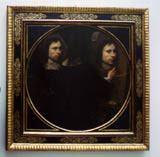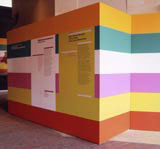Profile: Calum Storrie
Scotsman Calum Storrie’s art exhibition designs are informed by his architectural background, and he prefers his work to stay low key. John Stones asks about his new book and latest project set to open in London.

Scotsman Calum Storrie’s art exhibition designs are informed by his architectural background, and he prefers his work to stay low key. John Stones asks about his new book and latest project set to open in London
There are large egos, there are small egos and then there are the quiet egos – which is what Calum Storrie, the softly-spoken Scot, who has carved out a niche designing art exhibitions, professes to have.
The oversized personalities that Storrie (pictured) encounters on a daily basis are not only those of artists – alive or dead – whose visual character dominates the exhibitions he designs, or the eminent architects – present and past – who designed the spaces in which the exhibitions take place, but the often rather fraught curators and museum staff. ‘People are interested in making their mark,’ observes Storrie, before adding, with a wry smile, that ‘diplomacy is what is needed’. It’s just as well Storrie says he ‘doesn’t want to impose’ and is happy about his ‘lack of a signature style’.

His latest exhibition design is a case in point – it’s a show dedicated to 17th century Dutch landscape painter Jacob van Ruisdael, at the Royal Academy’s Lord Foster-designed Sackler Wing. Ambitious design proposals, to enable oil paintings to be displayed alongside etchings and drawings, were, once again, diluted down – victim to the usual pressure of making more space for the pictures. Sometimes, however, there is the chance for more elaborate designs, such as the lightboxes he created for Princess Margaret’s former apartments at Kensington Palace (with graphics by his frequent collaborator Sans & Baum).
But do not mistake Storrie as an advocate of the recent trend to elevate the exhibition design to the primary display. ‘There is room for both approaches,’ he says tactfully, but unconvincingly, adding, ‘Some exhibitions really need it.’ The influence of retail design on exhibitions is something he abhors. Museums should be ‘an alternative to shopping’, he says firmly. ‘You can come and visit the British Museum’s [again Foster-designed] Great Court without going into the museum, which is a great shame.’
The British Library Reading Room, once a hive of academic activity, now stripped of its life blood, is typical of the kind of multi-layered environment that – in its previous incarnation – tickles Storrie’s fancy. His business card is a library card with arcane information on one side and his details stamped on the other, with an e-mail address that transforms his name into ‘calumny’. ‘I hope I don’t sound like an old fogey,’ he worries.
While temporary exhibitions are his bread and butter, it’s the world of permanent exhibitions that is the fodder of Storrie’s freshly published book The Delirious Museum/ A Journey from the Louvre to Las Vegas, which is a rhapsodic stroll around the concept of a virtual museum. ‘The street and the way we walk though cities’ are Storrie’s inspiration for both the book and his exhibition design. ‘I really like the idea of a journey through a city, that is full of surprises, dead ends and diversions. This is what undermines the sense of a ‘closed narrative’ that many exhibitions aspire to, and enhances the visitor’s experience. This can be quite subtle – it is not necessarily theatrical,’ he explains.

Offers to do stage design, unsurprisingly, do not appeal to Storrie, and his architectural approach is evident in his recent design for the Self Portraits show at the National Portrait Gallery in London. He placed a red wall at a diagonal through the space, unifying an awkward area, without creating banal corridors.
Storrie studied architecture in Dundee, before coming to London in the 1980s. At Jasper Jacob Associates, he got to design the Royal Academy’s Greek Icons exhibition in 1987, and thought, ‘This is a nice way to spend your time’. He formally set up on his own in 1998, after working in-house at the British Museum.
Another couple of exhibitions are in the pipeline at the Royal Academy: Modigliani and his Models; and Chola Bronzes, an exhibition of South Asian sculpture. But Storrie is particularly enthusiastic about a project with Polish-born artist Goshka Macuga, for this year’s Liverpool Biennial. Macuga’s art consists of sourcing and ‘curating’ the work of others for her own installations – here a recreation of the set of the 1920s classic film The Cabinet of Dr Caligari. Storrie will help take it from a concept to a physical reality. It’s exactly the kind of subtle, yet complex design game that Storrie will relish.
The Delirious Museum: A Journey from the Louvre to Las Vegas is published by I B Tauris
Jacob van Ruisdael: Master of Landscape runs from 25 February to 4 June at the Royal Academy of Arts, Piccadilly, London W1
-
Post a comment



